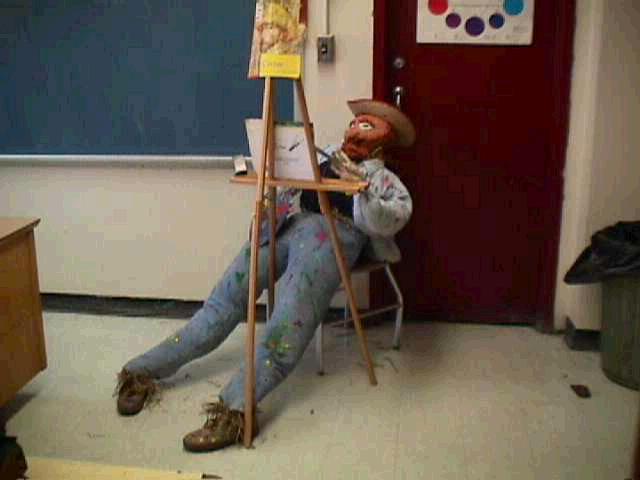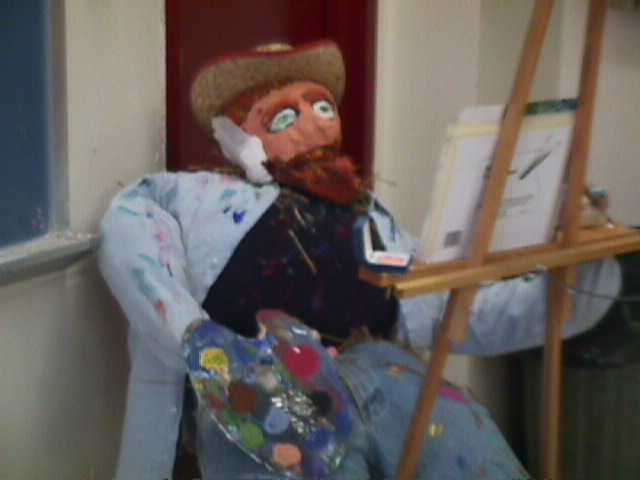Vincent
Van Gogh
by
Lori Langsner
AIMS:
1.
We will learn about the Post-Impressionist artist, Vincent Van Gogh.
2. We will learn to interpret and
appreciate Van Gogh’s unique painting style.
3. We will analyze and interpret Van
Gogh’s painting; “The Starry Night”.
4. We will explore and investigate
the unique relationship Van Gogh had with his brother, Theo, and the effect this
relationship had upon his work.
5. We will develop our auditory and
visual thinking skills as we listen to, and interpret the lyrics of the song;
“Vincent” by Don McLean.
6.
We will create a line drawing in the style of Van Gogh’s Starry Night,
entitled “Scary Night” to celebrate the Halloween season.
GRADE
LEVEL:
7th grade art talent classes
ESTIMATED
TIME:
One month, class meets 4 times per week for 40 minutes
SETTING:
Art classroom
INTERDISCIPLINARY
AREAS: Language Arts, Music
DO NOW:
1.
Read “Forces of Nature” -
Scholastic Art:Sept./Oct. 1999, Vol.30, No.1
2.
Answer the following:
1. Which element of art was most important to Van Gogh?
(line)
2. What unique painting
techniques did Van Gogh use in his paintings?
(straight lines, black outlines, empty spaces, scratches, dots and
dashes)
3. Describe Van Gogh’s brushstroke.
( thick, thin, long, short, wide, and narrow)
4. Why is The Starry Night one of Van Gogh’s most famous paintings?
(based less on nature than the artist’s inner feelings and emotions)
5. Why did Van Gogh have such a sad life?
(painted only 10 years,
HOMEWORK:
Using
the Internet, www.vangoghmuseum.nl
investigate the
How did his brother Theo encourage
and support Van Gogh?
How had a history of mental illness
finally destroy his life?
MOTIVATION:
Students will listen to Don McLean’s “Vincent”, while viewing a poster reproduction of Van Gogh’s Starry Night.
They will be asked to describe what they see and what they hear. Elicit from students that this painting is not a natural landscape, but rather a reflection of the artist’s moods and emotions.
Give
background information that Van Gogh painted this when he was confined to a
mental institution. “What could
this mystical night be symbolizing for Van Gogh?”
“How do the lyrics of the song
help us interpret Vincent’s feelings when he created this painting?”
(And when no hope was left inside on that Starry, starry night, you took
your life, as lovers often do. But
I could have told you Vincent, This world was never meant for one as beautiful
as you......Vincent was suffering, no one understood, and through his color and
brushstroke he was alive with feelings and emotions that the world only
understood after he was gone.)
MATERIALS:
sketchpads,
pencils, 9”x12” color construction paper, craypas (oil pastels)
Halloween pictures, reproductions of Starry Night
PROCEDURE:
1.
To distinguish Post-Impressionism from Impressionism, students will compare and
contrast works by Monet, Renoir and Degas, with Van Gogh, Cezanne, and Gauguin.
2. Students will list the underlying differences in these artist’s approach to their paintings. “What was Van Gogh most concerned with?” (emotion expressed through color and brushstroke) “What was Cezanne trying to achieve?” (solidity in rounded forms through color and texture) Gauguin wanted to use imaginative colors, unlike the Impressionists who were concerned mostly with the ever changing effects of light on color.
3. Students will read aloud and
share their homework biographical studies of Van Gogh. Highlights would
include his various short careers in the ministry and as an art teacher.
How he was happiest in the South of France.
The great influence his brother Theo had on his career.
The names of some of his most important works.
The real story as to why his cut off his ear. The final tragedy of how he
only painted for 10 years and then committed suicide.
4.
Using Starry Night as the impetus, students will draw a similar landscape in
their sketchpads. They will then
substitute Halloween ghosts,
5.
Students will draw on colored construction paper and color with the same intense
colors and brushstrokes (lines), using the art medium, craypas.
6.
Completed drawings will be displayed on class bulletin boards to add to the
spirit of the Halloween season.
7.
Class evaluation and critique will follow.
EVALUATION:
1.
What was Van Gogh’s greatest achievement?
2. How did the Van Gogh web sites further your understanding of this artist?
3. Why were the Post-Impressionists
different from the Impressionists?
4.
Why do you think Van Gogh’s life story is so tragic?
5.
How do our Scary Night drawings
compare with Van Gogh’s Starry Night? How
are they similar/different?
6. Which drawings do you like best?
Why?
7.
Which of Van Gogh’s paintings are your favorite?
Why?
ANECDOTES:
1.
When student’s are first asked; “Who was Vincent Van Gogh?” they usually
reply; “Isn’t he the one that
cut off his ear?” After this
lesson, students were able to really know and understand this artist in a much
different light.
2. In keeping with the Halloween holiday spirit, a school wide scarecrow contest was held. Our class created a life-size scarecrow of “Vincent Van Crow”, complete with palette, brush and easel with canvas of Starry Night, bloodstained bandage over his ear, and ear in a gift box to give to his girlfriend. Needless to say, we won first prize!
 |
 |
ADDITIONAL LINKS:
STUDENT WORK SAMPLES:
FOLLOW-UP ACTIVITIES:
Class trip to the Museum of Modern Art in New York to see Van
Gogh’s original "The Starry Night."